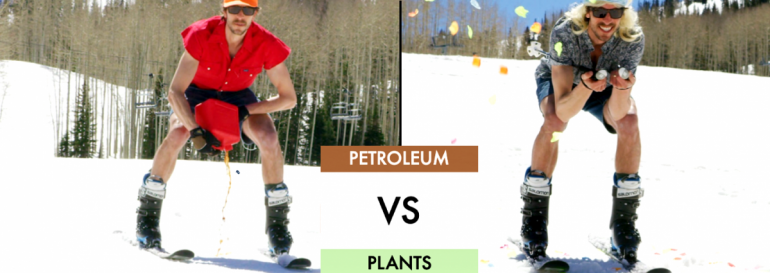Plant-based wax: a solution to pullution? We speculate.
What’s in your wax? If you have ever leaned over a waxing table in a poorly ventilated garage, you’ve probably asked this question. Depending on the brand, purpose and the amount of money exiting your wallet, it is likely a petroleum based product containing hydrocarbons or, even worse, the dreaded perfluorocarbons. It seems only fitting that in the similar poorly ventilated garage just down the street from WildSnow HQ in Carbondale, Colorado, Peter Airlein has been huffing his own special waxing blends. This time he has left the petroleum out of the equation and is focused on 100% plant-based ski wax.
Lou doesn’t necessarily think years of petroleum sins can be absolved by just switching to a new ski wax, but he is willing to give it a try. His take: “Back a few years ago, a guy with dreads down to his butt told me I’d be running my truck on fry fat from McDonalds ‘Within ten years!’ I believed him. Or, actually, I wanted to believe him. As one does in these eschatological days of planet ending gasses, one grasps at straws. Or fries.
“Well, I’m indeed running my truck on old flowers, seeds and stems. But they’re not from McDonalds. Rather, they’re from somewhere deep in the shale of North Dakota, where a bunch of carbon based life wadded up, got smothered by geological activities, and in about 350 million years became my much appreciated diesel fuel. Okay. I’d still love to run my truck on fry grease. Next best thing: wax my skis with vegetables?”
Enter the latest in plant-based technology: last year, mountainFLOW (known for their skin wax and anti-snow build up spray), came out with an eco-friendly ski wax in a quick application paste version. They are now setting their sights to a melt-on plant-based hot wax.
In general we avoid covering non-existent products here on WildSnow. But the way this fits into the increasingly popular trend of environmentally-friendly ski products, it asks to be written on. Plus, it’s not often to find someone else in Carbondale that spends as much time in his garage as we do. With big brands like the North Face about to release their new FutureLight fabric that claims “the highest performance and the lowest footprint,” and Patagonia long producing products with a more sustainable slant, the outdoor industry as a whole is moving in the green direction. Recent studies have shown that consumers will pay more for a product deemed sustainable, and it’s been off to the races across the industry.
If you take into account the manufacturing forces behind it, skiing, even in the backcountry is not an inherently “sustainable” sport. But, in these days of micro-plastic particles and diesel particulates, could there be one small thing that would chisel away at pollution? Seems like “plant-based ski wax” (at least that’s based on plants recently harvested, instead of those from the Carboniferous era), could be a good thing. So consider this blog post an invitation to the Kickstarter for what appears to be a viable product.
According to the Kick: “Plant wax is endlessly interesting as there are hundreds of plants from which a wax can be extracted. Through a proprietary combination of waxes we found the perfect attributes for a ski wax–glide, hydrophobicity, durability, and ease of application. Other plant-based ski waxes have been made primarily with soy. While we do use some soy wax in our product, it makes up a small percentage of our formula. Instead we are using a combination of waxes that are faster and more durable…”
We have, however, seen this before. Back in 2011, we wrote a review of Green Ski Wax. This product has seemingly disappeared from the web. There are modern products in Europe, though, like NZero Wax which uses a blend of soybeans and corn. In the U.S. we’ve got a few biodegradable (though not entirely plant-based) options from Purl Wax and Swix. But all in all, the stuff hasn’t quite taken off. Does that mean it doesn’t work? Or does it mean modern ski society wasn’t yet ready to embrace it on a large-scale level?
Yet to be seen, as this is all pretty speculative. There’s a fair amount of information on the Kickstarter site as to what mountainFlow is doing differently than others. It’s got some good momentum already. At time of publication, just over 24 hours since it was launched, the Kickstarter has received over 100 backers and has raised over $6300.
The jury is out on whether we’ve truly reached the critical social (and literal) climate for widespread change in the industry, and whether eco-friendly stuff can replace its polluting counterparts on the basis of merit and effectiveness, not just trendiness. Hopefully, after careful testing, we can report news in this direction, but, that’s yet to be seen.
Meanwhile, back to blotting the fuel oozing from freedom fries, and, is that Kool-Aid in that jug, or real orange juice? We’re optimistic.
Editor’s Note: This article is the teaser for additional coverage of mountainFlow. Stay tuned for a Q&A with Arlein next week where we’ll dive deeper into the process of developing a plant-based ski wax and the state of ski waxes industry wide.
While most of the WildSnow backcountry skiing blog posts are best attributed to a single author, some work well as done by the group.

